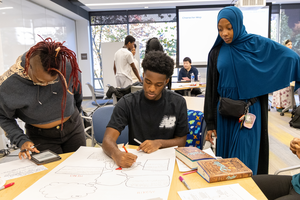From kindergarten to high school classes to schools of law and medicine, educators are offering mindfulness as a strategy to enhance students’ academic performance and to support their physical and mental health. Mindfulness, an antidote to the wandering mind, is focused awareness in the present moment. The most common mindfulness practice is to focus on breathing while holding thoughts and sensations in nonjudgmental awareness. Research on mindfulness in educational settings suggests that such practices may support psychological resilience, enhance emotional self-regulation, increase working memory, and improve focus and concentration.
Here are five tips for integrating contemplative practices into the classroom:
Develop your own regular mindfulness practice first.
Mindfulness is an experiential discipline. Knowing about mindfulness is not enough—actually doing it is the only way you can benefit from it and model the practice for your students. Recordings of guided meditations, which are widely available for download from the web, are an easy way to get started.
Plan mindfulness activities that will increase your students’ awareness and that are developmentally appropriate:
- Preschool: Very short (1-5 minutes) tactile activities, such as using hand gestures to go with each breath, resting a stone on the belly to notice the rise and fall of the belly with each breath.
- Elementary school: Short (1-10 minutes) body-focused activities, such as mindful belly breathing or mindful eating (chewing a raisin); or emotional literacy exercises, such as locating an emotion in the body or describing the emotion’s color.
- Middle school: Short (5-10 minutes) sitting meditations, physical relaxation techniques, mindful eating exercises, or active listening exercises.
- High school: Longer (working up to 20 minutes) sitting meditations, body awareness scans, or other activities that increase awareness of the breath, body, or emotions.
Get parental buy-in for mindfulness activities.
Share research findings on the effectiveness of mindfulness with colleagues, parents, and administrators to emphasize the scientific basis of mindfulness-based activities. Emphasize that mindfulness is not tied to any religious tradition. Invite parents to join a classroom mindfulness session so that they can see for themselves what it is all about.
Familiarize yourself with the existing mindfulness curricula for students.
A number of mindfulness resources are available for teachers, including A Still Quiet Place, Mindful Me, and Mindful Schools (for elementary schoolers), Learning to BREATHE (for middle and high schoolers), and The Inner Resilience Program (for all grades).
Stop. Focus. Breath.
Bringing mindfulness into the classroom begins with cultivating your own present-moment awareness. As the teacher, you are modeling mindful awareness for your students. Mindfulness is a practice, not a body of knowledge. Strive to be anchored in your own awareness—your own breathing—as you create the time and space for your students to do the same.

Subscribe to the Educator's Playbook
Get the latest release of the Educator's Playbook delivered straight to your inbox.
Media Inquiries
Penn GSE Communications is here to help reporters connect with the education experts they need.









